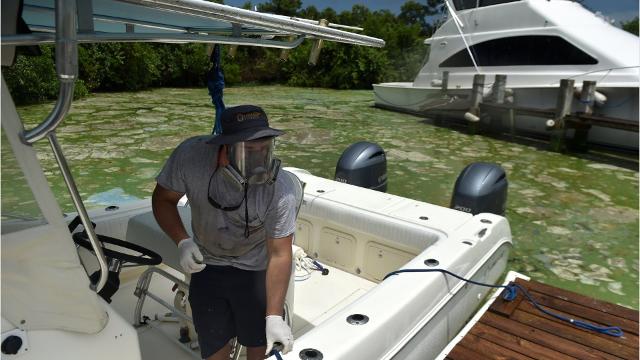The GOP has stopped, blocked and inhibited at every turn any effort to use state or federal regulation to protect water quality in Florida. Elected Republicans use specious arguments like "federal overreach" and when it is time to loosen state laws, they do things like exchange hard numerical standards for "narrative" ones.
Well it turns out those narrative standards are utterly failing at protecting public health and the environment. Public health, as in severe and permanent neurological diseases.
In DC, the GOP is determined to gut the federal protections of the Clean Water Act.
To get really sick -- perhaps not today but down the road -- you don't have to TOUCH cyanobacteria. All you have to do is BREATHE.
So don't "hold your breath" and vote for Republicans this November. Principled conservatives need to keep saying it like George Will and Bill Kristol have: VOTE DEM.
The GOP yard needs to be bulldozed and re-sodded. Only voters can do that.
Updated 17 hours ago

Originally Published 12:29 p.m. EDT July 18, 2018
Well it turns out those narrative standards are utterly failing at protecting public health and the environment. Public health, as in severe and permanent neurological diseases.
In DC, the GOP is determined to gut the federal protections of the Clean Water Act.
To get really sick -- perhaps not today but down the road -- you don't have to TOUCH cyanobacteria. All you have to do is BREATHE.
So don't "hold your breath" and vote for Republicans this November. Principled conservatives need to keep saying it like George Will and Bill Kristol have: VOTE DEM.
The GOP yard needs to be bulldozed and re-sodded. Only voters can do that.
Toxic blue-green algae is really cyanobacteria, plus other facts about blooms, microcystin

Video: Blue-green algae through the years
The problem dates back to 1923. DACIA JOHNSON/TREASURE COAST NEWSPAPERS
Wochit
Algae blooms from different sources are popping up throughout the Treasure Coast.
The green slime is polluting the St. Lucie River in Martin and St. Lucie counties and Blue Cypress Lake in Indian River County.
Here are some things you should, but may not, know about it:
It's not really algae
Blue-green algae is actually cyanobacteria, naturally occurring microscopic bacteria that, like plants, use photosynthesis to produce food from nutrients and sunlight.
A combination of things can cause normal levels of blue-green algae to explode into a full-tilt bloom: high levels of nitrogen and phosphorus from fertilizer runoff and septic tank leakage; long, hot days; and low salinity.
The normally salty St. Lucie River estuary is susceptible to algae blooms only when there are high freshwater inflows from canals and Lake Okeechobee discharges.
Blooms can harm an ecosystem like the St. Lucie River by killing the tiny organisms at the bottom of the food chain, oysters and sea grass. And when the bloom dies, bacteria eating the dead cells suck all the oxygen out of the water, which can cause fish kills.
Toxic threat
A species called Microcystis aeruginosa has been the primary blue-green algae in St. Lucie River blooms. It produces several toxins, including one called microcystin.
Microcystin can cause nausea and vomiting if ingested and rash or hay fever symptoms if touched or inhaled. Drinking water with the toxins can cause long-term liver disease.
Breathing in fumes from blooms with microcystin can cause respiratory problems, particularly in people with asthma or pulmonary disease.
An Ohio State University study found people living in areas with significant blue-green algae blooms containing microcystin are more likely to die from nonalcoholic liver disease than those in areas without the blooms. The study did not conclude blooms cause liver disease, especially not in particular individuals.
A growing number of scientists think another toxin in the algae, known as BMAA, can trigger diseases such as Alzheimer's, Parkinson's and amyotrophic lateral sclerosis, also known as ALS or Lou Gehrig's disease.
Concentrations of toxins in blue-green algae are measured in parts per billion. The World Health Organization considers water with up to 1 part per billion safe to drink and more than 10 parts per billion to pose a health threat from recreational contact.
Other algae
Another blue-green algae found in the Indian River Lagoon, lyngbya often looks like masses of brown seaweed floating on the water, especially in the summer.
Lyngbya (LING-bee-yah) can be toxic to fish, plants and other marine creatures and cause a skin irritation known as “swimmer’s itch" in humans.
It grows rapidly in water with high levels of fertilizer and septic runoff, so blooms are a sign of an unhealthy lagoon.
Brown tide
Aureoumbra lagunensis, a true algae (not cyanobacteria) known as "brown tide," is more common in the northern and middle Indian River Lagoon as far south as Sebastian.
The aftermath of a brown tide bloom in mid-March 2016 in the Banana River, an arm of the Indian River Lagoon that stretches from Kennedy Space Center to just north of Melbourne in Brevard County, killed millions of fish.
Scientists suspect the bloom absorbed all the nutrients in the river, then died. Bacteria eating the dead cells sucked all the oxygen out of the water, and the fish suffocated.
Updated 17 hours ago
1 comment:
Republicans are ruining the earth one molecule at a time and unfortunately Democrats are the sit-on-their-ass no-vote party. VOTE Damn it!
Post a Comment